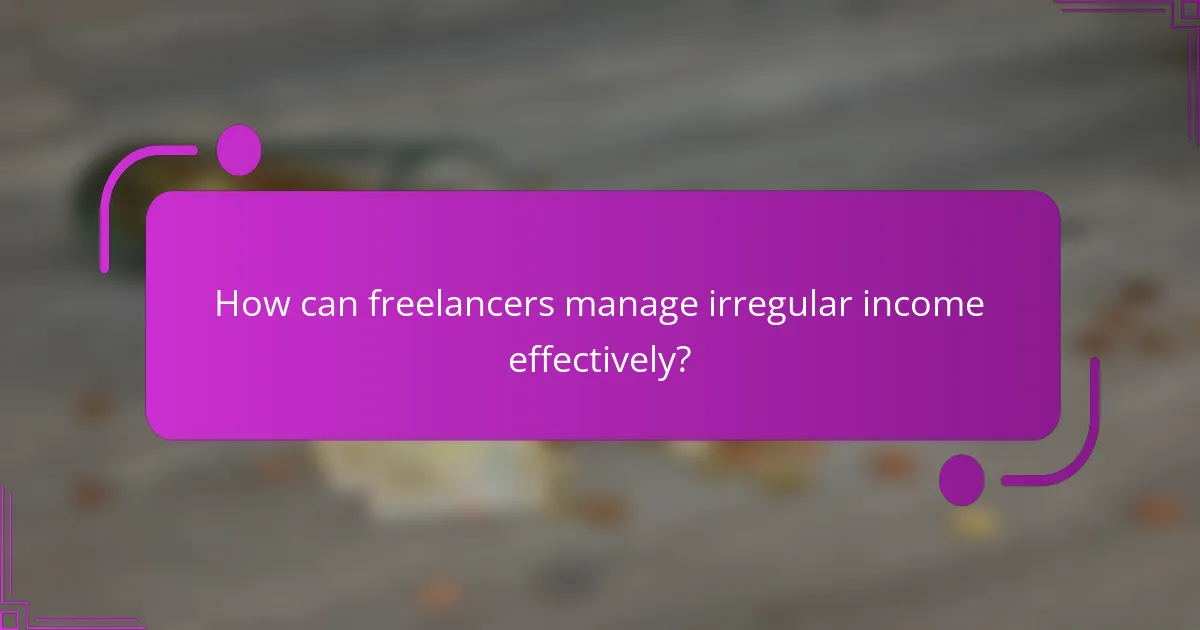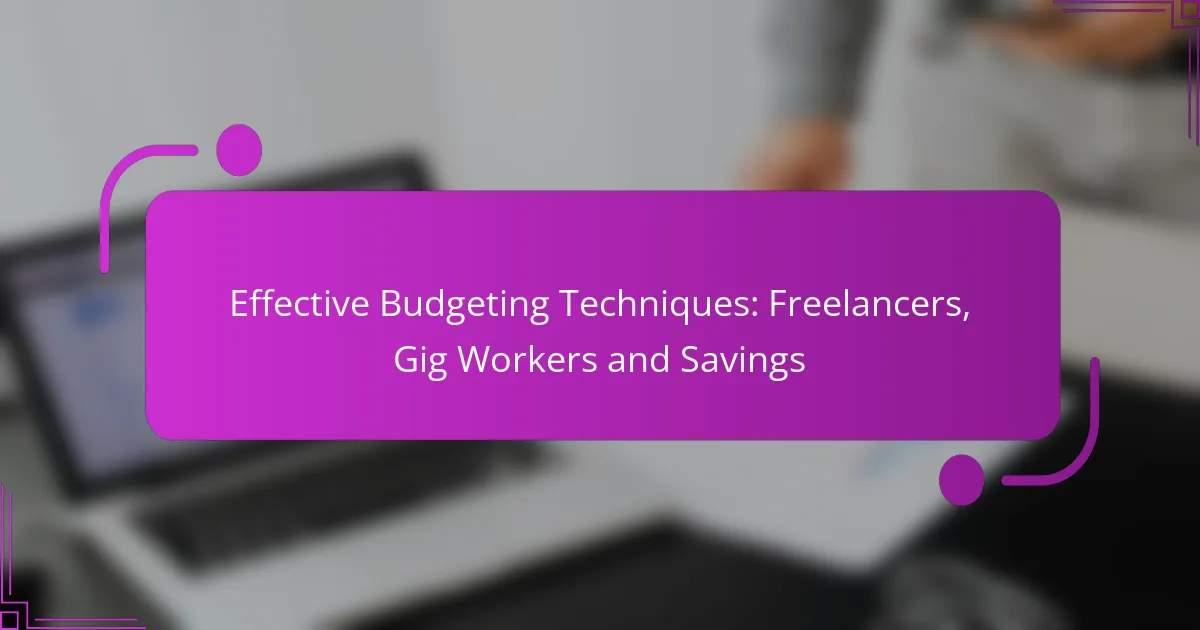Effective budgeting techniques are essential for freelancers and gig workers to navigate income variability and achieve financial stability. By adopting structured methods and utilizing budgeting tools, they can allocate funds wisely, save for taxes, and prepare for lean periods, ultimately building a solid savings foundation to support their financial goals.

What are effective budgeting techniques for freelancers?
Effective budgeting techniques for freelancers help manage income variability and ensure financial stability. By implementing structured methods, freelancers can allocate funds wisely, save for taxes, and prepare for lean periods.
Zero-based budgeting
Zero-based budgeting requires freelancers to allocate every dollar of income to specific expenses, savings, or debt repayment, ensuring that income minus expenses equals zero. This method encourages careful consideration of each expense, making it easier to identify unnecessary costs.
To implement zero-based budgeting, start by listing all sources of income and all expenses, categorizing them into fixed and variable costs. Review and adjust your budget monthly to reflect changes in income or expenses.
50/30/20 rule
The 50/30/20 rule divides income into three categories: 50% for needs, 30% for wants, and 20% for savings and debt repayment. This simple framework helps freelancers prioritize essential expenses while still allowing for discretionary spending and savings.
For example, if a freelancer earns $3,000 monthly, they should allocate $1,500 for needs, $900 for wants, and $600 for savings or debt. Adjust these percentages based on personal financial goals and circumstances.
Envelope system
The envelope system involves allocating cash for different spending categories into separate envelopes. This method can help freelancers control spending by limiting how much they can spend in each category.
To use this system, determine your budget categories, such as groceries, entertainment, and savings. Withdraw cash for each category and place it in labeled envelopes. Once the cash is gone, no more spending occurs in that category until the next budgeting period.
Cash flow forecasting
Cash flow forecasting helps freelancers predict future income and expenses, allowing for better financial planning. By estimating cash flow over a specific period, freelancers can identify potential shortfalls and adjust their budgets accordingly.
Create a cash flow forecast by listing expected income and expenses for each month. Update this forecast regularly to reflect actual income and expenses, helping to maintain a clear picture of financial health.
Expense tracking apps
Expense tracking apps simplify the process of monitoring spending by automatically categorizing transactions and providing insights into financial habits. These tools can help freelancers stay on top of their budgets and identify areas for improvement.
Popular apps like Mint, YNAB (You Need A Budget), and PocketGuard offer features such as expense categorization, budgeting tools, and financial goal tracking. Choose an app that aligns with your budgeting style and regularly review your spending patterns to make informed financial decisions.

How can gig workers maximize their savings?
Gig workers can maximize their savings by implementing strategic financial practices that focus on automation, high-interest accounts, and retirement planning. By utilizing these techniques, freelancers can build a robust savings foundation that supports their financial goals.
Automated savings plans
Automated savings plans allow gig workers to set aside a portion of their income without having to think about it. By linking a savings account to their checking account, freelancers can schedule regular transfers, ensuring consistent savings even during fluctuating income periods.
To implement this, choose a percentage of each payment to transfer automatically. A common recommendation is to save at least 10-20% of each paycheck. This method not only simplifies saving but also helps in building an emergency fund over time.
High-yield savings accounts
High-yield savings accounts offer better interest rates compared to traditional savings accounts, making them an excellent choice for gig workers looking to grow their savings. These accounts typically provide interest rates that can be several times higher than the national average.
When selecting a high-yield savings account, look for options with no monthly fees and easy access to funds. Online banks often provide competitive rates, so consider comparing several institutions to find the best deal. Aim for accounts offering rates above 1% APY to maximize your earnings.
Freelancer retirement accounts
Freelancers should consider retirement accounts like a Solo 401(k) or a SEP IRA to save for the future while benefiting from tax advantages. These accounts allow for higher contribution limits compared to traditional IRAs, making them ideal for gig workers with variable incomes.
For a Solo 401(k), you can contribute both as an employee and employer, potentially allowing contributions up to $58,000 or more, depending on income. A SEP IRA allows contributions up to 25% of your net earnings, with a cap of $66,000. Choose the account that best fits your income level and retirement goals to ensure a secure financial future.

What budgeting tools are best for freelancers and gig workers?
Freelancers and gig workers can benefit from budgeting tools that help track income variability and manage expenses effectively. The right tool can simplify financial planning, ensuring that savings and expenditures align with fluctuating earnings.
Mint
Mint is a popular budgeting tool that offers a user-friendly interface for tracking income and expenses. It automatically categorizes transactions, allowing freelancers to see where their money goes and adjust their spending habits accordingly.
One of Mint’s key features is its ability to set budget limits and send alerts when spending exceeds those limits. This can help gig workers stay on track and avoid overspending, especially during lean months.
YNAB (You Need A Budget)
YNAB is designed with a proactive approach to budgeting, encouraging users to allocate every dollar they earn. This method is particularly useful for freelancers who may experience irregular income, as it helps prioritize spending and savings.
With YNAB, users can create specific categories for expenses and savings goals, making it easier to manage cash flow. The platform also offers educational resources to improve financial literacy, which can be beneficial for those new to budgeting.
EveryDollar
EveryDollar is a straightforward budgeting tool that emphasizes simplicity and ease of use. Users can create a monthly budget by entering their income and expenses, making it suitable for freelancers who prefer a no-frills approach.
The app allows for customizable categories and provides a clear overview of financial health. While the free version is effective, the paid version offers additional features like bank syncing, which can save time for busy gig workers.

What criteria should freelancers consider when choosing budgeting methods?
Freelancers should evaluate their income variability, types of expenses, and financial goals when selecting budgeting methods. Understanding these criteria helps in creating a budget that accommodates fluctuating earnings and supports long-term financial stability.
Income variability
Freelancers often experience inconsistent income, which can complicate budgeting. It’s crucial to assess income patterns, such as seasonal fluctuations or project-based earnings, to determine a suitable budgeting approach. For instance, some freelancers may benefit from a zero-based budget during high-income months and a more conservative approach during lean periods.
Consider setting aside a portion of your earnings during peak months to create a financial cushion for slower times. A common practice is to save around 20-30% of your income for these fluctuations, ensuring you can cover essential expenses when income dips.
Expense types
Identifying and categorizing expenses is vital for effective budgeting. Freelancers typically face fixed costs, like software subscriptions and office supplies, alongside variable costs, such as travel and client-related expenses. Understanding these categories allows for better allocation of funds and prioritization of spending.
To manage expenses effectively, create a detailed list of all costs and classify them into fixed and variable categories. This clarity helps in identifying areas where you can cut back during tight financial periods, ensuring that essential expenses are always covered.
Financial goals
Setting clear financial goals is essential for freelancers to maintain focus and motivation. Whether it’s saving for retirement, building an emergency fund, or investing in professional development, having specific targets helps guide budgeting decisions. Aim for both short-term and long-term goals to create a balanced financial strategy.
To track progress, consider using the SMART criteria—specific, measurable, achievable, relevant, and time-bound—when defining your financial objectives. Regularly review and adjust your budget to align with these goals, ensuring that your spending habits support your desired financial outcomes.

How can freelancers manage irregular income effectively?
Freelancers can manage irregular income by establishing a solid budgeting strategy that accounts for fluctuations in earnings. This involves tracking income, setting aside savings, and planning for lean months to maintain financial stability.
Establish a baseline budget
Creating a baseline budget is essential for freelancers to understand their minimum monthly expenses. Start by listing all fixed costs such as rent, utilities, and subscriptions, then estimate variable expenses like groceries and transportation. This baseline helps identify how much income is needed to cover essential expenses.
Consider using budgeting tools or apps to track these expenses and visualize spending patterns. Aim to keep your baseline budget flexible to accommodate changes in income or unexpected expenses.
Create an emergency fund
An emergency fund is crucial for freelancers facing income variability. Aim to save at least three to six months’ worth of living expenses to cover periods of low income. This fund acts as a financial cushion, allowing you to manage unexpected costs without derailing your budget.
To build your emergency fund, set aside a percentage of each paycheck, even if it’s a small amount. Automating these transfers can help ensure consistent savings.
Implement a savings strategy
Freelancers should implement a savings strategy that aligns with their income patterns. Consider the 50/30/20 rule, where 50% of income goes to needs, 30% to wants, and 20% to savings. Adjust these percentages based on your income fluctuations and financial goals.
Additionally, explore high-yield savings accounts or investment options to grow your savings over time. Regularly review and adjust your savings strategy as your income and expenses change.
Track income and expenses regularly
Regularly tracking income and expenses is vital for freelancers to stay on top of their finances. Use spreadsheets or financial software to record every payment and expenditure, making it easier to identify trends and adjust your budget accordingly.
Set aside time each week or month to review your financial situation. This practice helps you remain aware of your cash flow and prepares you for any upcoming financial challenges.



